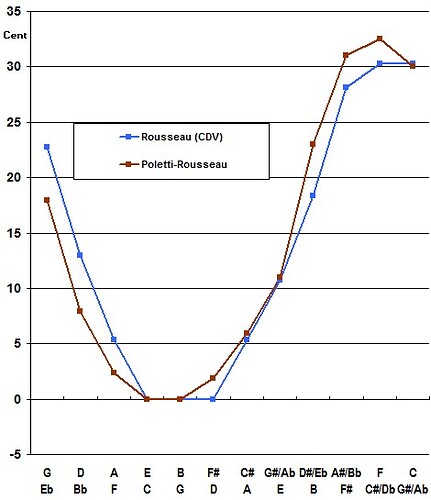I find that I did photocopy the chapter of Barbieri’s book in which he discusses the history of what we call French Ordinaire. It opens with Barca, in the 1750’s, finding d’Alembert’s described temperament abominable - it is noteworthy for performance practice that in the mid-1750s we find two musical writers of the same opinion about this pattern described by d’Alembert, including d’Alembert himself, while twenty years later Rousseau plagiarizes and elaborates on the same pattern, and considers it a good tuning. I think we can safely say that Rousseau was definitely outside the mainstream of opinion at the time he was writing.
Barbieri finds evidence of the beginnings of the pattern we call ordinaire in an Italian text as early as the 1620s, with CE described as just and both FA and GB described as wide. Barbieri cites a number of other Italian and French sources describing tuning of this sort in the interim leading up to d’Alembert. Hence, it is clear that there was a practice, even if not well or accurately documented, in which circularity is approached, that this practice occurred parallel to what seems to have been the predominant tradition of mean tone, and that this was occurring in Italy as well as France. (Indeed, this kind of tuning is also documented earlier, going back to Schlick in Germany).
It may well be that the irregular tuning practice described in Italy was introduced by Italians into France, since many Italian musicians made their way into the French musical life of the time, in court and beyond, during the 17th and 18th centuries.
While the derivation of Vallotti was mathematical calculation, he drew from a long tradition of tuning practice in which circularity is aimed at, starting with better thirds and proceeding to wider ones. Ordinaire derives from mean tone (a series of equally narrow fifths), with the effort to make it circular by varying the sizes of the fifths, trying by ear to start with “good thirds” and then close the circle in some way that is musically viable, rather than accept the clear limitations of mean tone. (Split keys, the alternative for at least extending the number of sharps and flats, are not terribly practical from any perspective). Vallotti came up with an elegant solution in which this is done very symmetrically.
Equal temperament is not a curse word, it is a solution to the problem of temperament. I see no reason to consider unequal temperament as “good by definition” and ET as “bad by definition.” All temperament is “bad by definition.” It necessarily involves compromise because of the nature of reality. Thirds, fifths and octaves are not compatible with one another. ET is the compromise in which everything is made the “least bad.” UETs make some things less bad by making other things worse.
In looking for what tuning to use for what music, we are trying to find out what compromise the composer and performing musicians of the time are likely to have used or preferred. There should be no particular judgmental criteria applied in examining the evidence.

